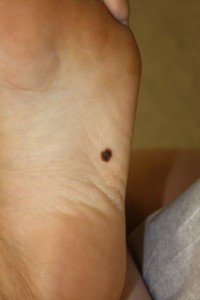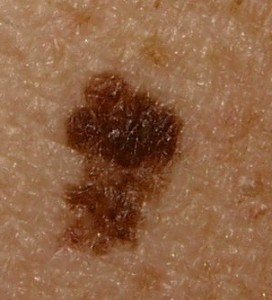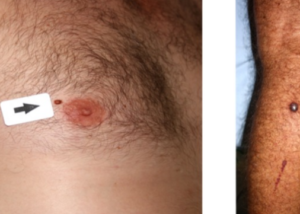
Melanoma on the bottom of a foot.
You of course may not think the tiny speck is melanoma, but over time, it’s going to get bigger or spread superficially.
How long does this take to happen, or to put it another way, how fast does this spreading or growth occur?
“Melanomas can either have not spread past the skin or already be metastatic by the time you find a 1 mm lesion,” says Dr. Jennifer Gordon, who is board certified by the American Board of Dermatology; she practices at Westlake Dermatology located in Austin, Texas.
Dr. Gordon points out, however: “A 1 mm lesion would be rare to be already metastatic.”
This would be the nodular type of melanoma, which is an uncommon sub-type of this skin malignancy.
“I realize this offers little comfort, but it is the unfortunate truth,” continues Dr. Gordon. “There are multiple types of melanomas, such as:
- Melanoma in-situ
- Lentigo maligna melanoma
- Superficial spreading melanoma
- Nodular melanoma
- Desmoplastic melanoma, etc.”
This is why a new, though tiny, spot or speck should not be ignored, even if it looks normal.

Melanoma
“Ultimately I believe genetics will help determine the behavior of these, but until we have that data we have to look at patterns,” explains Dr. Gordon.
“In general, survival rate of melanomas depends on depth of the cancer.”
This depth is determined by a dermapathologist who examines a biopsy of the suspicious spot, which includes a surrounding margin of skin also taken out, under a microscope.
The rule of thumb is that the height of the melanoma above the surface of the skin is equal to its depth below the skin surface.
Dr. Gordon explains, “In general, smaller lesions (and the earlier you detect them) — the thinner they are and the better outcomes people have.
“Some melanomas will grow in a spreading pattern on the skin [the superficial spreading type], but some will grow in a deep pattern that are more aggressive [nodular type].
“There is no easy way to decipher the spread of melanoma until it is biopsied and sometimes until further tests are performed.”









































